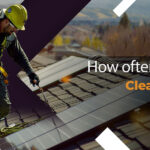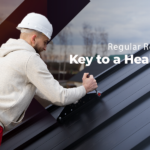What Chemicals You Can Use to Clean Your Roof Shingles
Your roof shingles bear the brunt of weathering and dirt accumulation over the years. From moss and algae to lichen and general grime, various elements can mar the appearance of your roof and potentially compromise its functionality. Cleaning your roof shingles is essential not only for maintaining curb appeal but also for extending the lifespan of your roofing material. But it is not always sufficient to only clean roof with water. For its proper cleaning, there are varied chemicals available in the market. But with so many options, how would you choose the suitable one? Let’s dive into the best options and how to use them safely.
Need for Cleaning Roof Shingles
Over time, organic matter like algae and moss can grow on your shingles, especially in shaded or damp areas. This not only affects the aesthetic appeal of your home but can also lead to shingle deterioration. Algae can cause discoloration and stains, while moss and lichen can lift shingles and trap moisture. Therefore, leading to potential leaks and structural issues.
Regular cleaning helps prevent these problems, preserves the integrity of your roofing material, and can even enhance energy efficiency by keeping your roof’s reflective properties intact.
Chemicals Safe for Cleaning Roof Shingles
When selecting a chemical cleaner for your roof shingles, it’s essential to choose products that are effective yet gentle enough not to cause damage. Here’s a rundown of some of the most commonly used and effective chemicals for roof cleaning:
1. Sodium Hypochlorite (Household Bleach)
Overview: Sodium hypochlorite, commonly known as household bleach, is a popular choice for cleaning roof shingles. It’s effective at killing algae, mold, and mildew.
How to Use:
- Mixing: Mix one part bleach to three parts water to dilute the bleach; this ratio usually works effectively. Some tips recommend adding a small amount of detergent to help the solution adhere to the shingles.
- Application: Use a pump sprayer to apply the solution evenly over the roof surface. Allow it to sit for 15-20 minutes but avoid letting it dry completely.
- Rinsing: Rinse the roof thoroughly with water to remove any residual bleach. Avoid using high-pressure water, as it can damage the shingles.
Precautions: Bleach can be harsh on plants and grass, so cover or water them before application. Also, protect your skin and eyes by wearing appropriate safety gear.
2. Oxygen Bleach (Sodium Percarbonate)
Overview: Oxygen bleach, or sodium percarbonate, is a gentler alternative to chlorine bleach. It’s effective at removing stains and organic growth without the harshness of chlorine.
How to Use:
- Mixing: Dissolve oxygen bleach in water according to the manufacturer’s instructions. A typical ratio is about 1 cup of oxygen bleach to 1 gallon of water.
- Application: Using a low-pressure pump sprayer or a garden sprayer, apply the solution to the roof.
- Rinsing: Let it sit for 15-20 minutes, then rinse thoroughly with water.
Precautions: Oxygen bleach is less likely to damage surrounding vegetation and is generally safer for the environment.
3. TSP (Trisodium Phosphate)
Overview: Trisodium phosphate is a powerful cleaner that can remove heavy grime and stains. It’s often used for cleaning exterior surfaces before painting but is also effective on roof shingles.
How to Use:
- Mixing: Combine TSP with water, usually about 1 cup of TSP per gallon of water.
- Application: Apply the solution to the roof with a brush or sprayer. Scrub gently to help loosen dirt and grime.
- Rinsing: Rinse well with water to get rid of any remaining TSP.
Precautions: TSP is a strong chemical, so wear gloves and eye protection. Be cautious around plants and grass, as it can be harmful.
4. Commercial Roof Cleaners
Overview: There are numerous commercial roof cleaning products specifically formulated for different types of roofing materials. These cleaners are often tailored to target specific issues like moss, algae, or lichen.
How to Use:
- Follow Instructions: Always follow the manufacturer’s instructions for mixing and applying the cleaner.
- Application: Use the recommended method, whether it’s a sprayer, brush, or sponge.
- Rinsing: Rinse the roof as directed to ensure all residues are removed.
Precautions: Commercial cleaners are designed to be effective yet gentle on roofing materials. However, it’s essential to use them according to the instructions to avoid damage. Authorized roofers in New York take all the necessary precautions while working with these chemicals.
General Tips for Cleaning Roof Shingles
Regardless of the cleaning solution you choose, here are some general tips to ensure effective and safe roof cleaning:
- Check the Weather: Select a mild, dry day without rain for cleaning to prevent dilution or premature washing of the cleaning solution.
- Safety First: Always use a sturdy ladder and consider employing a harness for added safety. Hire a professional if you’re not comfortable working on roofs or at heights.
- Avoid High Pressure: Do not use high-pressure washers, as they can damage shingles and push water underneath them, potentially causing leaks.
- Protect Plants and Landscaping: Cover nearby plants, shrubs, and grass with plastic sheeting or tarps to protect them from chemical exposure. Water them thoroughly before and after the cleaning to minimize chemical absorption.
- Test First: Test your chosen cleaning solution on a small, inconspicuous area of the roof to ensure it doesn’t cause discoloration or damage.
- Regular Maintenance: Regular maintenance and cleaning can help prevent heavy build-up and prolong the life of your roof. Clean your roof every 1-2 years, depending on the local environment and the amount of organic growth.
How Often Should You Clean Roof Shingles
Certainly! Here’s a bullet-point list of how often you should clean your roof shingles:
- Every 1-2 Years: For most residential roofs, cleaning every 1-2 years helps remove accumulated debris and prevent algae, moss, or lichen growth.
- After Severe Weather: Clean your roof after severe weather events (e.g., heavy storms, high winds) to remove debris and check for damage.
- If You Notice Growth: Clean your roof as soon as you notice significant growth of moss, algae, or lichen.
- For Shaded Areas: Roofs in shaded or damp areas may need more frequent cleaning due to higher moisture levels encouraging growth.
- Before Major Repairs: Clean the roof before any major repairs or maintenance to ensure the surface is clear and accessible.
- Check Local Conditions: Adjust cleaning frequency based on local environmental conditions such as humidity, rainfall, and the presence of trees.
Conclusion
For the aesthetic and health of your property, roof shingle maintenance is essential. Utilise the right tools and methods to get rid of pollutants, algae, and stains. Prioritise safety and follow the manufacturer’s guidelines. For knowledgeable guidance on long-lasting roof conditions, speak with an expert.
DSS Roofing, an authorize contractor in Buffalo, offers top-tier roofing services delivered by experienced and professional roofers. Known for our expertise and commitment to quality, DSS Roofing ensures that every project, whether residential or commercial, meets the highest standards. Our skilled team handles everything from installation to repairs, providing reliable solutions that enhance the durability and appearance of your roof. Trust DSS Roofing for exceptional service and craftsmanship.



